
A part of the Alaska Range as seen from Talkeetna, with the Talkeetna River in the foreground. The major peaks from left to right are Mt. Foraker, Mt. Hunter, and Mt. McKinley.
October 1999
There is something about Alaska that is very alluring. Maybe it's the size, the remoteness, the romance of America's last frontier. I've heard people say that there is nothing that can compare to Alaska's sheer natural beauty. So when I had the chance to go up there, I was full of anticipation.

A part of the Alaska Range as seen from Talkeetna, with the Talkeetna River in the foreground. The major peaks from left to right are Mt. Foraker, Mt. Hunter, and Mt. McKinley.
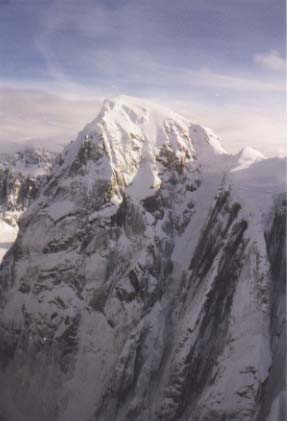
After arriving in Anchorage, I drove north on the George Parks Highway to the tiny town of Talkeetna, about 60 miles southeast of Mt. McKinley. It was a crisp clear autumn day. A perfect day for a sightseeing flight of the peaks of the Alaska Range. I booked a one hour flight with K2 Aviation, and boarded their Cessna 185 single engine plane. We took off from the small strip at Talkeetna and headed northwest to the snow covered peaks. Mt. McKinley, or Denali as the native Athabascans call it, is an impressive mountain, rising to over 20,000 feet. What is more, the nearby plains on which Talkeetna is located is a mere 300 feet above sea level, making the mountain look even taller. We quickly found ourselves amidst the rocky peaks, flying around mountains and over passes. Seen from a distance, Denali dominates the Alaska Range with its height and massive size, but once up close, it becomes clear that there is a whole lot more to see. The jagged peaks, with faces so steep that they can't even hold snow. Hanging glaciers hundreds of feet thick, high atop the rocky peaks. Glaciers more than two miles wide flowing ever so slowly through the valleys while continuously carving and changing the landscape. Words nor pictures can come close to describing the amazing scenery which lay all around us. At one point, we found ourselves flying straight at a massive wall of rock. As the pilot explained the formation and told us that it was called the "Moose's Tooth", the wall continued to fill the windscreen until all we could see was the light brown granite of the mountain. Having finished his explanation, the pilot casually banked the plane to the left and turned away, leaving me and the other passenger wide-eyed with hearts pounding.
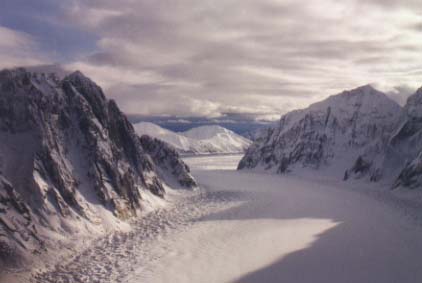
More images from the aircraft: Above: Flying along the Kahiltna Glacier as it winds its way amongst the peaks. The glacier is over a mile wide! Below: Looking out the windscreen of our Cessna 185. You can see one of the propeller blades as it spins.
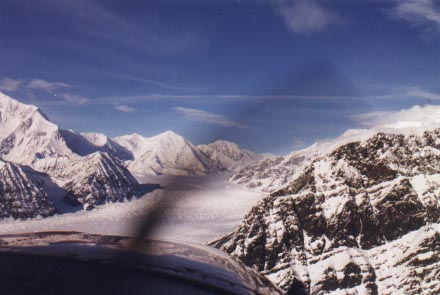

That evening, I looked up at the sky and hoped that it would remain clear. I wanted to see the northern lights. I'd seen photos and documentaries on television, but I wanted to see it in person. I asked around and found out that the light show usually starts around midnight and lasts for a couple of hours. I woke up at around 1:30 in the morning and ventured outside. I found a clearing with an unobstructed view of the northern sky and then I saw it. A band of green light stretching all the way across the sky. It was faint, but it was definitely there. I was in awe. The lights danced around gracefully, almost like they were curtains in a gentle breeze. After a couple of minutes, the light wavered a little and then slowly disappeared. A few minutes later, it reappeared and was accompanied by a second band of green light, just below it. I kept watching in awe as this cycle of fading and reappearing continued. I was mesmerized by the beauty of the lights and incredibly happy to have been able to witness it.
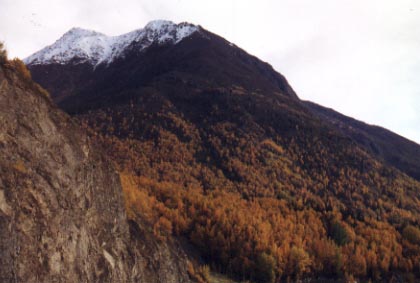
Above: The lower slopes of the Chugach Mountains just south of Anchorage are lit up with bright yellow autumn colors.
Below: A mix of evergreens and deciduous trees along a small dirt road above the tiny town of Hope.
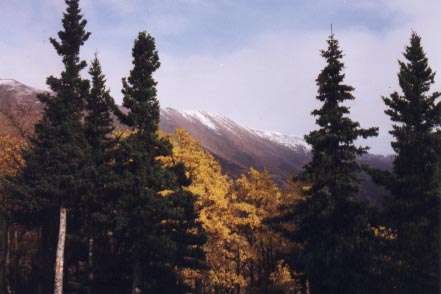
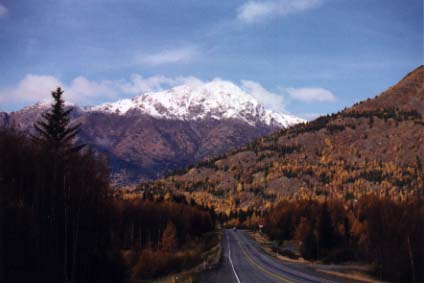
From Talkeetna, I drove back south, through Anchorage and onto the Kenai Peninsula. The mountain scenery was simply amazing. It was well into autumn and the snowline had dropped to about 2000 feet. So, the tops of the mountains were covered by snow, while the lower slopes were ablaze with the golden color of birch leaves. The beautiful scenery was non-stop all the way to the coastal town of Seward where I was greeted by a bald eagle perched high atop a tree. Seward is the launch point for almost all adventures into the adjacent Kenai Fjords National Park. The Park has an incredible array of steep sided fjords, with forested slopes rising almost vertically from the shoreline. Tidewater glaciers flow from the mountains high above directly into the frigid waters of the inlets. The sheer size of these glaciers is incredible. The Aialik Glacier is a mile and a half wide and a few hundred feet thick! With the motor of our tour boat turned off, the only sound we could hear in the silence of the Alaskan wilderness was the creaking and cracking of the ever moving glacier, and the occasional thunderous roar as a new iceberg was calved from the face of the glacier and crashed down into the ocean below.
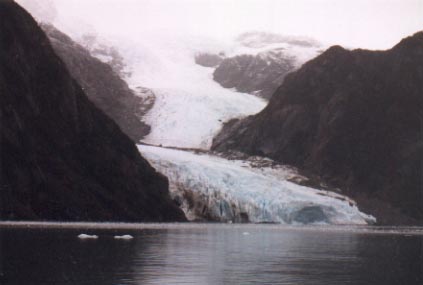
This is Holgate Glacier, one of the many glaciers we saw on our tour of Kenai Fjords.
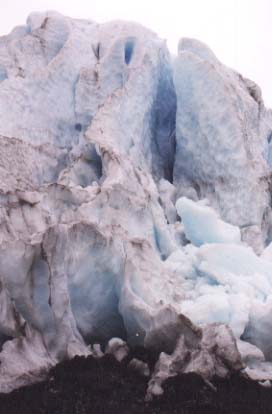
Back on land, another of Kenai Fjords National Park's attractions is Exit Glacier, a tongue off of the vast Harding Icefield. It is located just a couple of miles north of Seward and is pretty easily accessible. There's a hiking trail that climbs alongside Exit Glacier up to the Harding Icefield, but I didn't have time to do that. Next time.